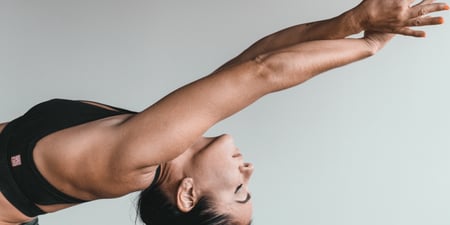
Vinyasa yoga, based on the flow of breath and movement, is a very popular style of yoga because it is challenging and dynamic. There are plenty of variations of Vinyasa, so it can be tailored to fit any person’s needs.
In this blog, we discuss the most popular Vinyasa yoga styles.
What is Vinyasa style yoga?
Vinyasa translates as “transition” and is a flowing, dynamic style of yoga. Vinyasa yoga emphasises movement and breath. The word “Vinyasa” implies “linking” or “connection,” and Vinyasa yoga is often called “flow” yoga because of the continuous flow of movement. Vinyasa yoga includes a series of standing, supine and seated postures. Your yoga class may consist of asanas such as sun salutation, upward facing dog, warrior poses, and child’s pose.
In Vinyasa classes, the poses are linked together by breath rather than muscle contractions. This makes Vinyasa yoga a more dynamic and fluid practice than Ashtanga yoga. In addition, Vinyasa often includes pelvic floor work and specific breathing techniques called pranayama.
You can take Vinyasa yoga classes online or in-person.
Types of Vinyasa yoga
Vinyasa has come to mean “breath-synchronised movement.” In other words, you move between physical postures on an inhale, or an exhale. A typical Vinyasa class will start with a sun salutation (a.k.a., a flowing sequence of yoga poses that warms up the body) and then move on to a variety of poses.
Each type of Vinyasa yoga below has its own set of particularities.
What is Vinyasa flow yoga?
Vinyasa flow yoga is a type of yoga that emphasises fluid movement. Asanas, or poses, are linked together in a flowing sequence, and the breath is used to guide the movement. This type of yoga is often called “flow” yoga because of the smooth, continuous way the poses flow from one to the next. Vinyasa flow restorative classes can vary widely in terms of pace and difficulty, but they typically involve more movement than other types of yoga, such as Hatha or Iyengar. Some people find flow-style yoga refreshing and energising, while others find it relaxing and calming. Regardless of your goal, flow yoga can be an excellent way to stretch and strengthen your body, and calm and focus your mind.

The benefits of Vinyasa flow yoga include:
- improved flexibility
- increased muscle strength and definition
- improved mind-body connection
- improved posture
- increased balance and coordination
- improved breathing and lung capacity
- increased cardiovascular endurance
- reduced stress[1] and anxiety levels.
There are some downsides to this type of yoga. It can be challenging to keep up with the flow of movement if you are new to yoga or not very flexible. Because Vinyasa flow classes can vary widely in difficulty, it is essential to find an appropriate class for your level. Your yoga teacher will show you different variations according to your current level; remember that you shouldn’t push yourself if an asana triggers any pain or physical discomfort (e.g., nausea, headaches, or dizziness).
What is hot Vinyasa yoga?
The pace of a hot Vinyasa class is often quicker than a regular Vinyasa class, and the room is typically heated to about 29 degrees Celsius. In some cases, though, the room temperature can reach 35 degrees. This combination of heat and movement can make for a sweaty physical practice! If you’re looking for a challenge and aren’t afraid of a little (or a lot) of sweat, hot yoga classes might be for you. Just be sure to hydrate before and after class, and take breaks as needed.
There are several benefits[2] to your hot yoga class.
The heat makes your body work harder, and it can be a great way to burn calories and tone the body. In addition, the heat helps to loosen up the muscles, which can make for a more comfortable practice. Hot Vinyasa yoga is also said to improve detoxification, circulation, and flexibility.
On the other hand, working out in a heated room has its drawbacks.
If you have any medical conditions, such as heart disease, diabetes, or high blood pressure, check with your doctor before taking a hot yoga class. And if you’re pregnant, you should avoid doing hot yoga
If you want to reap more of the benefits above, consider Bikram style hot yoga[3]. This style may also pose increased difficulties if you have pre-existing cardiovascular conditions, or are pregnant.
Your Bikram hot yoga class will follow the same sequence of 26 Hatha yoga poses and two breathing exercises performed in a room heated to 38 degrees Celsius with 40% humidity. The heat and the humidity help loosen your muscles, allowing you to achieve deeper stretches.
If you’re new to yoga practice or not used to working out in the heat, it’s essential to take it easy at first and listen to your body. Drink plenty of water, and don’t push yourself too hard. Remember, you can always take a break if you need to.
What is power Vinyasa yoga?
Power yoga is a type of yoga that became popular in America in the 1990s. It is a vigorous form of yoga that combines movement and breathing. There are several different types of power yoga, but they all have one thing in common: they are all more active than traditional yoga.
Power Vinyasa yoga is a physically demanding form of yoga that emphasises strength, flexibility, and stamina. The goal of power Vinyasa yoga is to build heat in the body, which helps to detoxify the muscles and organs. Because of the intensity of the practice, power Vinyasa is often considered a more advanced form of yoga. However, beginners can benefit from the challenges posed by it.

Power yoga brings you the array of benefits associated with aerobic and toning exercises.
For example, studies show that power yoga improves cardiovascular health[4]. As a form of aerobic exercise, it can enhance the health of your heart and lungs, lower your cholesterol and improve your sleep.
Power yoga, in particular, has also been linked to better motor control[5], stress reduction[6], and weight loss, thanks to an increased awareness[7] of your body.
What is dynamic Vinyasa yoga?
In dynamic Vinyasa yoga, the emphasis is on moving seamlessly - and faster - from one pose to the next. This type of yoga is often considered more challenging than other types of yoga because it requires heightened coordination and balance.
Dynamic Vinyasa yoga can provide various benefits, including improved flexibility, strength and stamina. You will also increase your mobility and strengthen your mind-body connection because dynamic Vinyasa yoga doesn’t let you zone out. This practice will keep you focused on the present, meaning it feels almost like a guided meditation.
Apart from the benefits to your nervous system, dynamic yoga helps you burn more calories than slower style yoga. This Vinyasa practice offers you a good workout because you’re doing strong toning movements while also using your entire body’s musculature.
There are some downsides, however. Not everyone can move quickly between these balance-challenging positions. If you’re a beginner, it’s essential to move at your own pace. This yoga experience lacks some of the dimensions and benefits of a mellower spiritual practice. The other styles of yoga above, such as flow and power, allow you to focus more on your thoughts.
Other yogas considered to be “Vinyasa”
Other types of yoga are considered Vinyasa, even though they have some distinct features from traditional elements of this practice. Here’s a guide.
Ashtanga yoga
Ashtanga Vinyasa is one of the most challenging yoga styles. This physical practice includes the typical series of poses and follows the principle of linking breath to pass from one asana to the other. These classes are for intermediate and advanced levels because they’re more physically demanding, requiring increased flexibility and endurance.
Ashtanga is derived from the Sanskrit words Ashta, meaning “eight,” and Anga, meaning “limb” or “part.” The eight limbs are the foundation of Ashtanga yoga, representing yoga sutras in this practice, such as ethical practices, self-discipline, and postures.
Ashtanga yoga is a progressive form of yoga having six series to master. Led classes are held for beginners but these progress to Mysore classes, in which the yoga teacher will offer corrections to your self led practice. All series begin with Surya Namaskar A and B, two versions of sun salutations, a dynamic warming flow.
Vinyasa teachers practising Ashtanga aim to improve your flexibility and strength, but also your mental well-being and self-esteem[8]. The quick flow of movements is designed to dispel mental blockages and enhance overall wellness.
While this yoga style is not the best for people with low physical conditions, your yoga teacher will adapt the practice to your current level.
Baptiste yoga
Baptiste Yoga is a Vinyasa-style yoga practice created by Baron Baptiste. This system[9] entails exercising in a room heated to 31-35 degrees Celsius. Classes involve a sequence of poses designed to challenge your endurance and strength while promoting detoxification.
The main pranayama used in Baptiste Power Vinyasa (BPV) is ujjayi. This type of breath[10] involves constricting the back of your throat as you inhale and exhale through your nose. It may take some practice, but eventually, it will become second nature. One advantage is receiving auditory clues that allow you to maintain focus on your breaths’s depth and regularity.

Baptiste yoga doesn’t feature a fixed series of poses, although most classes follow a specific pattern of Asanas. And, since Baptiste-style is a type of Vinyasa yoga, you will connect your movements to your breath. The breath focus tones and regulates your nervous system.
Yoga teachers encourage practising this style daily, whether you’re a beginner or not.
Apart from endurance, strength, proper alignment and detoxification, this restorative yoga focuses on improving mental clarity. Your instructor will advise you to fix your gaze on a specific point, or drishti, and soften your eyes during the class. As a result, you will direct your attention inside rather than on your surroundings to help achieve inner peace.
Jivamukti yoga
Jivamukti yoga is a type of yoga promoting both physical and spiritual development but emphasising the latter.. The word “jivamukti” comes from the Sanskrit language and means “liberation while living”. This practice was developed in the 1980s by yoga teachers Sharon Gannon and David Life. Jivamukti is based on the yoga sutras of Patanjali, incorporating elements from other yoga styles, such as Kundalini yoga and Hatha yoga. Jivamukti classes typically include chanting, meditation, breathwork, and a high energy physical practice. The goal of Jivamukti is to promote physical and spiritual liberation.
The core philosophy of Jivamukti yoga is realising that all humans are one. The practice aims to connect people with others and the universe. Once this connection is achieved, you can reach true happiness. That’s why the Jivamukti yoga community is remarkably united.
The five principles of Jivamukti[11] include:
- Shastra: studying ancient yogic teachings
- Bhakti: developing love through various devotional practices
- Ahimsa: practising nonviolence
- Nada: deep listening to enhance the mind-body conditions
- Dhyana: meditating regularly.
A Jivamukti yoga class is suitable for all levels, from beginners to advanced practitioners. The only requirement is an open mind and a willingness to explore your potential.
Prana flow
Prana flow is a type of Vinyasa yoga created by Shiva Rea. It is based on the traditional Ashtanga yoga, but it is not as rigid and doesn’t follow a set sequence of poses. Prana flow classes focus on linking breath with movement and emphasise smooth transitions between different asanas.
The main goal of Prana flow is to cultivate prana, the life force energy[12] that flows through the body. This type of yoga is said to increase vitality, creativity, and circulation. Prana flow classes are suitable for all levels and can be tailored to each individual’s needs.
Classes include chanting, music and breathing exercises meant to enhance your life energy. These exercises have a beneficial effect on your nervous system, like all the different types of yoga above.
Examples of Vinyasa yoga poses
The types of yoga above share in common the majority of yoga postures with each other and other forms of yoga. You will be asked to focus on your own breath and use your yoga mat during your class.

The different styles of Vinyasa yoga practised today include these poses.
- Sun salutations: A series of 12 postures performed in a sequence. They are usually done at the beginning of a yoga class to warm up the body.
- Downward facing dog: An inverted V-shaped pose that stretches the shoulders, hamstrings, and calves.
- Warrior I: A standing pose that strengthens the legs and opens the hips.
- Crow pose: A balancing pose that strengthens the arms and core.
- Tree pose: A standing pose that improves balance and concentration.
- Headstand: An inversion pose that strengthens the shoulders and core.
- Shoulder stand: An inversion pose that calms the nervous system and promotes better sleep.
- Fish pose: A reclining position that opens the chest and stretches the abs.
- Pigeon pose: A hip-opening stretch that relieves tension in the back and legs.
- Boat pose: A sitting position that strengthens the abs and improves balance.
- Camel pose: A kneeling position that opens the chest and stretches the front of the body.
Each style has its own take on these classic yoga poses. For example, in Jivamukti yoga, the crow pose is swapped out with “garuda”, a pose representing the mythical bird that carries the Hindu god Vishnu. In Prana flow, the warrior II pose is called “tiger” and is intended to represent the strength and power of the animal.
No matter what style you choose, you will ultimately benefit from the physical and mental challenges of Vinyasa yoga.

References
1. Acute and Cumulative Effects of Vinyasa Yoga on Affect and Stress among College Students Participating in an Eight-week Yoga Program: A Pilot Study. PubMD; 2014.
2. Roland J. 8 Benefits of Sweating It Out with Hot Yoga. Healthline; 2019.
3. Hewett ZL, Cheema BS, Pumpa KL, Smith CA. The Effects of Bikram Yoga on Health: Critical review and clinical trial recommendations. Evidence-based Complementary and Alternative Medicine; 2015.
4. Schubert MM, Clark AS, De La Rosa AB, Newcomer SC. Heart rate and thermal responses to power yoga. Complementary Therapies in Clinical Practice; 2018.
5. Controlled pilot study of the effects of power yoga in Parkinson's disease. PubMD;
6. Sullivan M, Carberry A, Evans ES, Hall EE, Nepocatych S. The effects of power and stretch yoga on affect and salivary cortisol in women. Journal of Health Psycholog; 2017.
7. Yoga in the Management of Overweight and Obesity. SAGE Journal; [cited on 2025 Jan 2].
8. Researchers testing therapeutic value of Ashtanga yoga for survivors of breast cancer. University of Windsor; [cited on 2025 Jan 2].
9. What makes Baptiste Power Yoga unique? Baptiste Institute; [cited on 2025 Jan 2].
10. Effects of yogic breath regulation: A narrative review of scientific evidence. ScienceDirect; [cited on 2025 Jan 2].
11. WHAT IS JIVAMUKTI YOGA? JIVAMUKTI YOGA; [cited on 2025 Jan 2].
12. Prana and electrons in health and beyond. NIH; [cited on 2025 Jan 2].
Disclaimer: This Content has been developed from our generous global community and is intended for informational purposes only. This Content is not, nor is it intended to be, a substitute for professional medical advice, diagnosis, or treatment and should never be relied upon. Further, the personal views and experiences published are expressly those of the author, and do not represent the views or endorsement of SoulAdvisor through the act of publication on our site.
































































